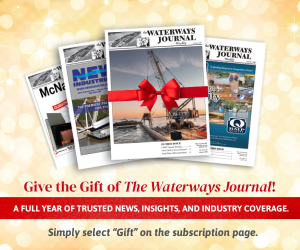The 2019 Flood—A Case Study in Maritime Governance
By Capt. Scott Stoermer
and Capt. Kristi Luttrell
The United States is a nation shaped by its inland and coastal geography. Deepwater access to Atlantic and Pacific seaways including a direct connection to the country’s agricultural heartland has had dramatic influence on the national economy, not to mention a myriad of domestic and international policies.
The history of this nation, from its Native American roots through its colonial infancy and modern status as a superpower, is overlaid by a connection to the sea. From our nation’s earliest days, the importance of capable ports and waterways was evident: “A few armed vessels, judiciously stationed at the entrances of our ports, might at a small expense be made useful sentinels of the laws.” (Alexander Hamilton, Federalist Paper No. 12, 1787)

The Mississippi River is a tried and true veteran and has borne witness to many nationally-defining experiences, including conflict, territorial expansion, trans-continental transportation, and the growth and redistribution of major metropolitan centers. The 1803 Louisiana Purchase, with the mighty Mississippi at its heart, equated to a one-time expenditure of roughly $18 per square mile. Current, conservative estimates indicate that the Mississippi River generates approximately $496 billion per year (Estimate taken from www.umrba.org/umr-econ-profile.pdf and www.lmrcc.org/programs/lower-mississippi-river-economic-profile/). So, in a single year, the nation’s return on investment for each square mile of the Louisiana Purchase is more than $599,000. Extrapolated over 216 years, the economic benefit of the heartland and its riverine connection to the coast is … priceless.

As a veteran, the river is also battle-tested, from the Battle of New Orleans in 1815 to this year—the longest flood fight in U.S. history. Disruptions to our Maritime Transportation System (MTS), whether a result of war or natural disaster, have always had significant impact. The growth of global supply chains and inter-connected trade have only served to add complexity. Despite the challenges of the 2019 high-water period—including more than 290 days above flood stage and damage that is only now coming into focus—the river, a lifeblood of our nation, added another survival story to its long history.
Shared Governance
On a daily basis, the women and men of the Coast Guard leverage unique authorities, jurisdiction and operational capabilities to safeguard the efficient and economical movement of maritime commerce. The influence of the Coast Guard in, on and around the maritime domain is arguably the most far-reaching of any government agency. Yet, successful maritime domain governance is not a solo sport; it requires the collaboration and active participation of a myriad of federal, state, and local agencies as well as the maritime industry.
Across the Midwest and inland river system, shared governance of the nation’s inland maritime domain was on full display during the unprecedented flood of 2019. Particularly, without the exceptional vigilance of the men and women of the U.S. Army Corps of Engineers, working to keep the river dredged and ensuring the levee systems operated as designed, it would not have been possible.
For the purposes of this discussion, maritime governance refers to the management of the MTS, in this case the Mississippi River. Its goal is to provide for the efficient, safe, secure and environmentally sound use of the system by a complex network of lawful users. Given its interstate nature, governance of the inland river system is inherently complex, with multiple—sometimes competing—layers of concurrent and exclusive jurisdictions. River and navigation infrastructure, navigation rules, vessel safety requirements, search and rescue resources and even local tax and fee processes are only some examples of facets of MTS governance. Yet, none these facets can be successful if approached as a go-it-alone endeavor.
Consequently, the concept of shared governance is of critical importance to success, both day-to-day and in response to contingencies. It is through shared governance that fully transparent communications, coupled with a flexible contingency response framework, can fully rise to the challenges of today and tomorrow.
Maritime governance is applied across the MTS. Nationally, the MTS is the multi-modal network of ports, rivers, channels and seaways that support seaborne commerce. Comprised of 361 defined ports, 95,000 miles of shoreline and 20,000 bridges all stitched together through 25,000 miles of navigable channel, the MTS is critically important to the nation’s economic prosperity and security. Our concept of the MTS and the need to effectively govern it has matured over time, as has the Coast Guard’s recognition of the need for partnership and a shared approach. Nothing should illustrate this more than the Coast Guard’s commitment to maintaining the waterway by initiating the Waterways Commerce Cutter project, which seeks to recapitalize our aging fleet of aids to navigation tenders.
From its earliest inception, the use of the inland river system for commercial transportation included governance mechanisms. While perhaps rudimentary by today’s standards, information on river conditions and hazards was relayed from river pilot to river pilot via riverside mailboxes where logs were updated by passing boats. That system’s DNA can be found in today’s digital Marine Safety Information network which transmits information via radio, internet and even boat-to-boat via modern Automated Identification System transceivers.
The Flood Of 2019
The flood of 2019 can be measured and counted in any number of ways, and this brief discussion is not meant to recount every aspect; yet, some contextual scale and scope facilitates the discussion of shared governance. As noted earlier, the flood of 2019 was the longest on record as measured at many locations on the Mississippi River alone. Over the course of the flood, all six of the U.S. Army Corps of Engineers districts and three Coast Guard Captains of the Port were simultaneously engaged in flood fight and waterway management efforts. The Bonnet Carré spillway was operated twice in one year—a historic first. St. Louis Harbor was also closed twice and for a total of 51 days, setting another historic marker. By nearly every measure by which floods and river systems are measured including all-time high water crests at numerous locations, the flood of 2019 set records.
Shared governance and a commitment to the mutual goals that underpin it provided several keys to success. At the largest scale, effective communication was fundamental to success of the system. In this case, it was communications between the Coast Guard, the Army Corps of Engineers and the maritime industry that most directly influenced realization of shared governance. The pre-existing, well-matured industry groups of the Mississippi River provided not only the mechanism for communications but also many pre-need relationships that set the stage for positive, collaborative dialog and consensus building. The success of the response to this year’s flood relied on the robust nature of these committees.
Perhaps slightly different from other events, this flood’s system-wide impact not only required inter-agency communications, but a heightened level of intra-agency communications as well. Speaking for the Coast Guard alone, each Captain of the Port had to be keenly aware of challenges in adjacent zones in order to effectively manage the system as a whole. The MTS Recovery Unit and its associated Common Access Reporting Tool functioned well in this capacity.
Communications Framework
Successful, meaningful communications were only part of the equation. A framework for those communications set the mutual understanding necessary for shared governance. For the inland MTS, this framework is the Waterway Action Plan (WAP). This pre-need framework has been developed over many years and covers every portion of the main-stem inland river system. As a playbook, it sets both “operational responses” as well as “operational considerations.” Generally, the “responses” are specific, time-tested waterway actions (e.g. harbor closures or daylight transit restrictions) triggered at specific gage readings. The true strengths of the WAP, however, are the outlined operational considerations. These considerations force rich conversation and compromise resulting in risk-based guidelines to meet the immediate contingency or circumstance.
Indeed, even in the short number of years since September 11, 2001, the advent of the Maritime Transportation Security Act, SAFEPORTS, the Marine Transportation System Recovery Unit and Waterway Action Plans have all played roles in facilitating commerce and protecting life and property. Any significant disruption to the MTS, whether man-made or natural, has the potential to cause cascading and devastating impact to our domestic and global supply chains. It seems clear that shared governance supports an effective and highly resilient system. In the case of the Mississippi River, shared governance increased safety, minimized impact and facilitated the quickest possible return to operations, thus protecting America’s economy and national security.
Capt. Scott Stoermer is commander of Coast Guard Sector Upper Mississippi River, and Capt. Kristi Luttrell is commander of Coast Guard Sector New Orleans.


